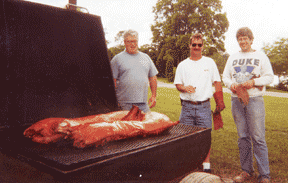|
|
 |
||||||||||
|
|||||||||||
|
|||||||||||
The Cape Anne Pig and Me
|
|||||||||||
 |
The author and pig-cooker, right, with Steve Goins, center, and Tom Kennedy. |
How to Cook a Pig
I most wanted to know how long to cook the pig. I thought I might have to start that instant and stay up all night.
In the little house in Cape Anne there were many, many cookbooks. Most of them had titles that included either the word vegetarian or 30 minutes. There were some old classics, but nothing about a pig, unless it was an essay about some memorable night in Italy or Polynesia, followed by how to recreate it all in a crock pot.
I looked next on the web. In my search, I took solace in one of my lessons of life. There are in the world thousands, if not millions, of cookbooks. Many of these books lay out exactly how, for example, a pork shoulder must be cooked. They maintain that if the pork shoulder is not treated by their prescription, many embarrassing and distasteful consequences will be realized. Many of these books directly conflict with others, and most produce a good pork shoulder. The lesson: people have been around a long time and getting things cooked by whatever means they have in front of them. It works out.
Adoration of the Meat
I got up early and started burning a mountain of charcoal in a steel fire pit. The cooker was going to require stoking with hot coals at regular intervals. Ideally, I was supposed to keep the cooker at 275 degrees; this is an ideal that I neither agreed with nor thought possible.
In an hour, I had fire, and with some help I hoisted the pig onto the grill, skin side up. We closed the top. I was committed, which required great discipline, to leave the top closed and not peek. I kept adding new charcoal in the drawer on the end of the pit. After four hours Tom and I put on gloves; he grabbed the legs, I grabbed the arms, and we turned the creature over.
Cape Anne BBQ SauceThis quick sauce can be used as made, mixed into the meat as it is chopped or for dipping at the table. It lasts in a jar for a few months but does not age well. North Carolina style sauces generally have no sugar, and Eastern North Carolina sauces have nothing red or brown in them. They are vinegar sauces, to be mixed into the meat as it is chopped. 1 quart apple cider vinegar 1 can (14 ounces) crushed tomatoes 3 Tbs. dried minced onion 2 Tbs. peppercorns, coarsely crushed 1 Tbs. crushed, dried cayenne 1 Tbs. garlic powder 1 Tbs. salt 5 bay leaves Combine ingredients. Bring to boil for about 5 minutes. |
At this moment, my apprehension about cooking a 130-pound pink creature disappeared. Browning meat on a fire is primitive and elemental. From some lobes and/or some cortex in the brain rush chemicals of emotion. Goofy, big-mouthed smiles are made. A hundred thousand years ago, maybe, seeing the animal on the fire meant that you would survive another two weeks. Today, in a fatted land on the edge of the Chesapeake Bay, these brain chemicals turn into pleasures, decadences and acceptable naughtiness. There is satisfaction knowing that you are capable of basic, essential simplicity: animal on a fire.
I poured sauce into the browning flesh. I put more fire into the drawer and closed the top. Having seen the crisping pig, I found it even more difficult to keep the top closed. A gathering crowd also wanted to see under the black lid of the cooker. We all wanted to look and feel that which is ancient: the primitive adoration of meat.
Young girls would see the meat, gasp, find some friends and watch.
Young boys would point at crisp pieces they wanted. They would conjecture about other animals available for cooking. They picked up small dogs.
Women would talk about the meat turning pink, a sign of slow cooking they had seen at some remote BBQ restaurant in the South.
Men offered to marry me. They told me of the restrictions levied by their wives. They remembered distant times in distant lands with rich feasts of celebrations. They spoke of moments of valor and accomplishment in gluttony.
I satisfied them all with a plate of trimmings I chopped and mixed with my own Cape Anne Sauce. There were forks full of fatty, crispy meat that I reserved for those closest to ecstasy.
Others approached with trepidation, trying to use the crowd to hide their approach. Some were vegetarians, seeking confidences from me.
A bold one finally asked for the meat from the cheeks.
How Good Was that Pig?
The pig, the sauce, it all worked. The next morning, three little boys, names unknown, walked up to me in my yard and held out five dollars. They said they had collected it, and they offered it to me for another pig.
This success further exaggerated my affiliation with pork. It is true that I have a rating system for barbeque restaurants. There are five categories.
Five, the best, is a destination. At least when I was less concerned about my carbon dioxide emissions, this meant you went out of your way, up to two hours, to go to the restaurant.
Four means that if you are in town, you make sure you go there.
Three means that if you live in town with the place, you go there regularly, and you take visitors.
Two means that you try someplace else, hoping for better.
One means you don’t go there even for a free meal if offered.
I give my pig, at least when fresh, a four.
Afterward
In 2004 I went on sabbatical to Livermore, California. While I was there Tom Kennedy died. Tom was part of the energy of Cape Anne. He had an old truck, cigars, a smile and was willing to dig a hole to cook a pig. Thank you, Tom.
p
North Carolina native Ricky Rood teaches at the University of Michigan. He lived on the Bay for more than 20 years and still returns. He writes a climate-change blog for Weather Underground. (http://www.wunderground.com/blog/RickyRood/show.html). Reach him at [email protected].
|
Current Issue \\ Archives \\ Subscriptions \\ Clasified Advertising \\ Display Advertising |
© COPYRIGHT 2007 by New Bay Enterprises, Inc. All rights reserved.

